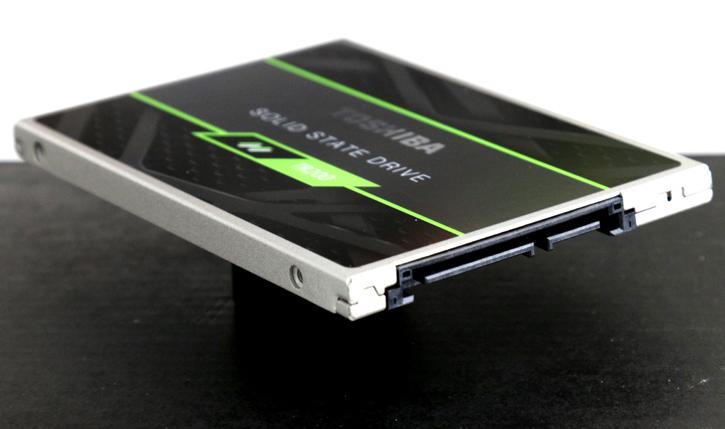Final Words & Conclusion
Final Words & Conclusion
The TR200 series has value written all over it as the transition towards BiCS 64-layer NAND was has written value all over it. As a value drive you will get TLC written NAND, some will hate, other don't care. The results abundantly show in the sustained writes where the actual write performance can seriously drop big-time. Normally a manufacturer bypasses that by adding a DRAM cache onto the SSD, the TR200 doesn't get that either. However, Toshiba opted to create an SLC written partition to deal with massive write loads, and that works for the bigger part. For the 960 GB model we calculated that SLC buffer to be at roughly 16GB that means workload of up-to 16GB will write at proper SSD values in the 400/500MB/sec writes. Once you keep stressing the SSD and pass that threshold, the performance will cave in. This by default is the nature of TLC written memory. Endurance wise I am not worries. A year or 2-3 ago it was a big topic as with TLC the NAND write cycles go down. over the year however there have been many wearing technologies introduced and this gave endurance a rather big boost. So yes, even an TLC written SSD will likely outlive your PC lifespan maybe even twice before it starts to really degrade. As the number show, everything connected towards SATA3 is hitting the SATA3 bandwidth limitation (at give or take 550 MB/sec), massive wall holding back potential performance. In order for companies to keep selling these puppies, they need to diversity on several segments. You can differentiate based on price (MLC versus TLC), you can differentiate on endurance (lots of TB written), you can differentiate on volume sizes (vertically stacked NAND rules) and obviously there's a level of service in after sales you can differentiate in. Basically the Toshiba TR200 SSD range will tick most of these boxes as you get very decent endurance, nice options in volume sizes, decent warranty but you do get TLC NAND (lot's of people still have their stomach turned around when they see TLC). Performance wise at this price level and being SATA3 bound we are not complaining really.
 |
||
| Unit | Msrp | Price per GB |
| Toshiba TR200 SSD 240GB | 83 | € 0,35 |
| Toshiba TR200 SSD 480GB | 149 | € 0,31 |
| Toshiba TR200 SSD 960 GB | 276 | € 0,28 |
Above the math based on manufacturer suggested retail prices, typically you can shave off another 10% in e-tail. The Toshiba TR200 SSD (TR = Trion ;) works well as read performance wise this product can easily attack the competition and remains over the ~550 MB/sec marker. And if you use your PC or laptop in a normal fashion like for the Internet and gaming, these SSDs will still be plenty fast. Write performance varies a bit based on volume size and workload of course due to the TLC nand versus that SLC write buffer, but overall you are in that 450~500 MB/sec marker until your buffer runs out. IOPS performance screams out loud and proud at that 80K marker for 4K random aligned reads, writes are a little lower but still close to perfect on a SATA3 SSD. Our trace testing shows impressive results as well. This is a trace test and can emulate what you guys do on your PC with spicy workloads focused on reads mostly.
Lifespan
Toshiba is using TLC NAND here, not always preferred by the majority of end-users that actually understands what the difference is. Interesting to see is that Toshiba offers sincerely nice TB written rates. 240 TBW is its value, do you write 133 GB a day for five your continuously? As that is the mathematical equivalent for the 960 GB model. Granted, that number halves for the 480 and again halves for the 240 GB model. But even then we're talking like 33 GB/day. Toshiba offers a warranty for 3 years. Previously know as the ShieldPlus warranty is now called the "Advanced Warranty program". It might sound like a large chunk of marketing, truthfully it's probably the best warranty program your money can get you as Toshiba will pick up and deliver a new SSD at your doorsteps at their cost in the event of an failure. What other company does that?:
- Serial Number Look Up - support can look up warranty coverage based on serial number
- Current product owners will receive a new (not refurbished) drive
-
A pre-paid return label is provided for supported SSDs
. - Replacement is shipped before the defective SSD is received
- Replacement is shipped next business day
Overall SSD Usage
An SSD is enjoyable, very much so. If you put a drive like this into your SATA 3 compatible laptop or SATA 3 compatible PC, you'll have no idea what is about to hit you. We very much enjoy the grand sustained performance of this SSD series. Make no mistake, replacing an HDD with an SSD in your desktop PC or laptop eliminates the random access lag of the HDD head, it is no longer mechanical. That, combined with the performance SATA 3 offers these days, is simply a massive difference and probably the best upgrade you can make for your computer anno 2017.
SATA Controllers
Some overall recommendations then. Should you be in the market for a SATA 3 SSD then we have a couple of hints though. First and foremost if you have a SATA-2 controller only on your motherboard, then you'll get limited at roughly 270 MB/sec read and writes. SATA 3 (6Gbps) will free you up from that allowing the SSD to perform in the 500 MB/sec range. It is however important that you connect your SSD to the proper controller. What you need to do is connect the SSD towards the native chipset port, e.g. the AMD or Intel chipset for best performance. Often 3rd party controllers like Asmedia controllers offer good performance but often can show 25% perf die to that controller or chipset PCIe lane configurations. Also make sure you run your SSD in AHCI mode, it does make such a difference in performance, a big difference.
Concluding
The TR200 series is Toshiba's answer towards the value propositions like the BX300 from Crucial and the 850 EVO from Samsung. The market is fierce and competitive. It's good, but not great as the TR200 is not the best performing unit when it comes to writes, you do have to position it at a proper place. For any regular PC this is more than okay as the read perf is excellent. It's only once the SLC cache runs dry where the write perf will drop. So for 90% of you this is an excellent drive. However if you get green pimples from TLC write performance we would always suggest to go with an MLC written unit as primary SSD, and perhaps a nice 960 GB TR200 at 28 cents per GB for your secondary storage like your games. That symbiosis might be the ultimate value proposition in relation to the money you put down. Endurance is just not something you need to worry about, of course any piece of hardware can die, but for our tested model we are allowed to write like 133 GB per day writes for 5 years. Combined with a 3 year warranty, I'd say you are good to go. Remember, it doesn't mean that once you have written that write value the SSD is dead. Often they will put on for a lot longer time-frame. Power consumption is now a even more in line with the competition, if you were planning to use one in a laptop at close to 1.6 Watts under load. If your workload is a more mainstream class gaming or Internet PC then we have to admit, this is could be a ideal. But only if you can spot the Toshiba TR200 960GB for the right price, other then that it's s fun little drive that offers value. As stated, pop it into any regular PC or laptop and you'll love it. And perhaps as secondary value game SSD it might even make more sense.
Recommended Downloads


